steering wheel Oldsmobile Cutlass Supreme 1993 Owner's Manuals
[x] Cancel search | Manufacturer: OLDSMOBILE, Model Year: 1993, Model line: Cutlass Supreme, Model: Oldsmobile Cutlass Supreme 1993Pages: 340, PDF Size: 16.21 MB
Page 53 of 340
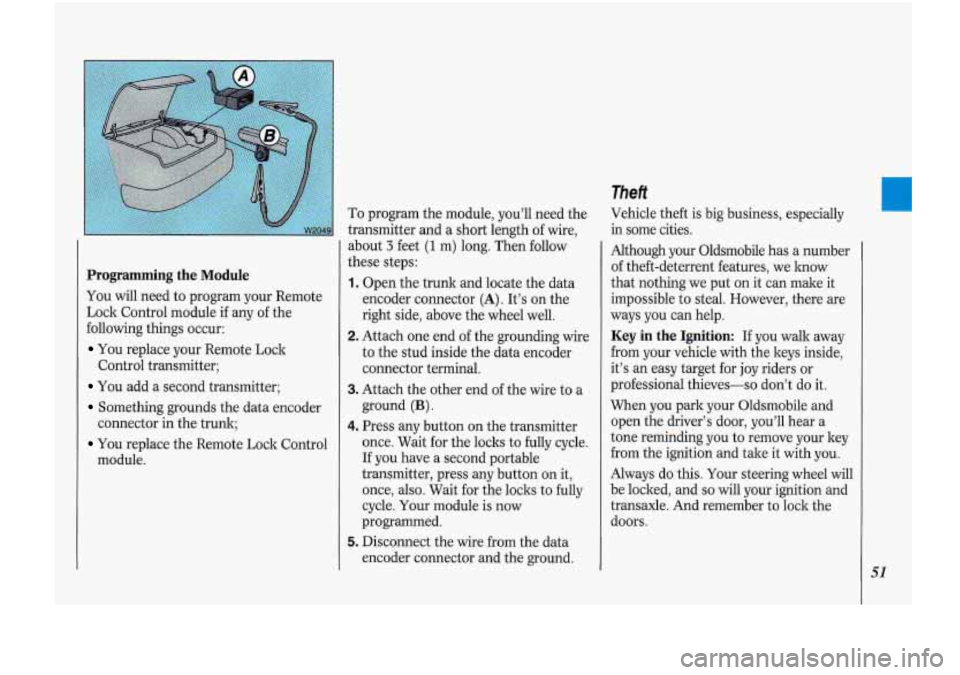
Programming the Module
You will need to program your Remote
Lock Control module if any of the
following things occur:
You replace your Remote Lock
Control transmitter;
You add a second transmitter;
Something grounds the data encoder
You replace the Remote Lock Control
connector
in the trunk;
module.
To program the module, you'll need the
transmitter and a short length of wire,
about
3 feet (1 m) long. Then follow
these steps:
1. Open the trunk and locate the data
encoder connector
(A). It's on the
right side, above the wheel well.
2. Attach one end of the grounding wke
to the stud inside the data encoder
connector terminal.
3. Attach the other end of the wire to a
ground
(B).
4. Press any button on the transmitter
once. Wait for the locks to fully cycle.
If you have a second portable
transmitter, press any button on it,
once, also. Wait for the locks to fully
cycle. Your module is now
programmed.
5. Disconnect the wire Gom the data
encoder connector and the ground.
Theft
Vehicle theft is big business, especially
in some cities.
Although your Oldsmobile has a number
of theft-deterrent features, we lmow
that nothing we put on it can make it
impossible to-steaL However, there are
ways you can help.
Key in the Ignition: If you walk away
from your vehicle with the keys inside,
it's
an easy target for joy riders or
professional thieves-so don't do it.
When you park your Oldsmobile and
open the driver's door, you'll hear a
tone reminding you to remove your key
from the ignition and take it with you.
Always do this. Your steering wheel will
be locked, .and
so will your ignition and
transaxle. And remember to lock the
doors.
51
Page 70 of 340
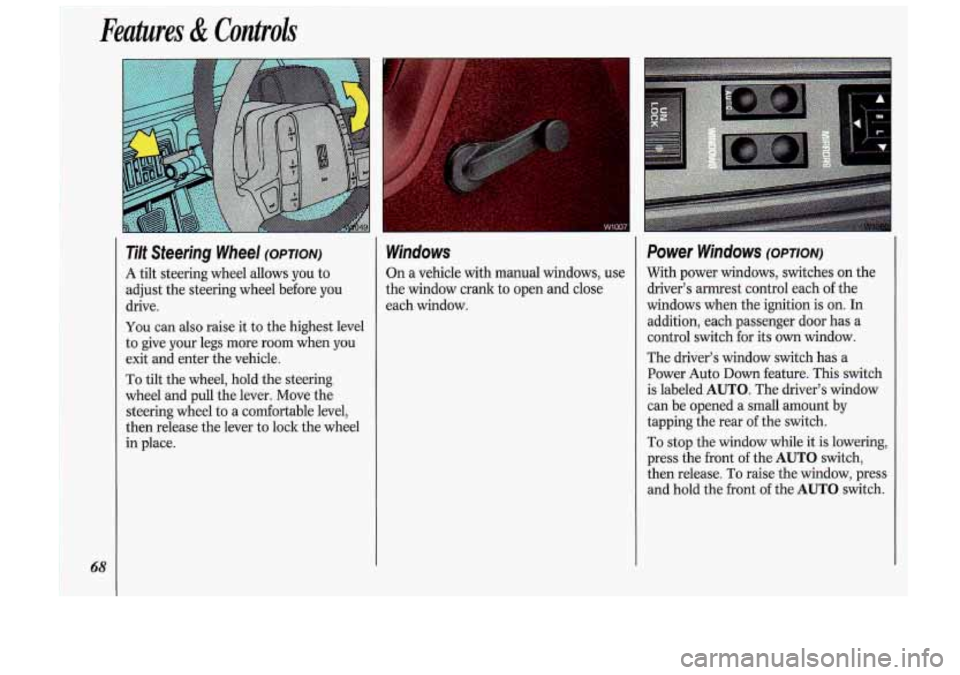
~ Features di Controls
Tilt Steering Wheel (OPTION)
A
tilt steering wheel allows you to
adjust the steering wheel before you
drive.
You can also raise it to the highest level
to give your legs more room when you
exit and enter the vehicle.
To tilt the wheel, hold the steering
wheel and pull the lever. Move the
steering wheel to a comfortable level,
then release the lever to lock the wheel
in place.
Windows
On a vehicle with manual windows, use
the window crank to open and close
each window.
Power Windows (OPTION)
With power windows, switches on the
driver’s armrest control each of the
windows when the ignition is on. In
addition, each passenger door has a
control switch for its
own window.
The driver’s window switch has a
Power Auto
Down feature. This switch
is labeled
AUTO. The driver’s window
can be opened a small amount by
tapping the rear of the switch.
To stop the window while it is lowering,
press the front of the
AUTO switch,
then release. To raise the window, press
and hold the front of the
AUTO switch.
Page 91 of 340

The Instrument Panel-
Your Information System
Your instrument panel is designed to let
you know
at a glance how your vehicle
is running. You’ll know how fast you’re
going, how much fuel you’re using, and
many other things you’ll need to drive
safely and economically.
The main components of your
instrument panel are:
1. Turn Signal/Headlight Beam Lever
2. Tilt Steering Wheel Lever
3. Indicator Lights
4. Instrument Cluster
5. Warning Lights
6. Gearshift Lever
7. Audio System
8. Glove Box/Fuse Panel
9. Vents
IO. Vents
11. Climate ControVRear Window
Defogger
12. Ashtray and Lighter
13. Vents
14. Ignition Switch
15. Hazard Warning Flashers Switch
16. Horn
17. Remote Trunk Release (Option)
18. Brake Release
19. Hood Release (on floor by driver’s
20. Light Controls
door)
89
Page 111 of 340

In this part you’ll find out how to
operate the comfort control systems
and audio systems offered with
your
Oldsmobile . Be sure to read about the
particular system supplied with your
vehicle
.
I Part 3
I Comfort Controls & Audio Systems
Climate Control ........................................................................\
.............................. 110
Electronic Climate Control
........................................................................\
.............. 113
Steering Wheel Touch Controls for Climate Control ............................................. 116
Setting the Clock
........................................................................\
............................. 118
AM/FM Stereo Radio ........................................................................\
...................... 119
AM/FM Stereo Radio
with Cassette Player .......................................................... 121
AM/FM Stereo with Cassette Player and Graphic Equalizer
................................ 126
Compact Disc Player Anti-Theft Feature
............................................................... 131
Audio Bass Control
........................................................................\
......................... 133
Understanding Radio Reception ........................................................................\
..... 133
Care of Your Compact Discs ........................................................................\
........... 135
Fixed Mast Antenna
........................................................................\
....................... 135
Power Antenna Mast Care ........................................................................\
............. 135
AM/FM Stereo with Cassette Player and Music Search ........................................ 123
AM/FM Stereo with Compact Disc Player ............................................................. 129
Steering Wheel Touch Controls for Audio System
................................................ 132
Care
of Your Cassette Tape Player ........................................................................\
134
109
Page 118 of 340

116
Comfort Controk &Audio Systems
Steering Wheel Touch Controls
for Climate Control
(OPTION)
Some heating and cooling controls can
be adjusted at the steering wheel. These
touch controls also operate some audio
controls. See the
Index under Steering
Wheel
Touch Controls for Audio
System.
FAN: Press the upper part of the
control to increase the fan speed; press
the lower part to reduce the fan speed.
TEMP: Press the upper part of the
control to raise the inside temperature
setting; press the lower part to lower
the setting.
MODE: This control can be used to
select the direction of air flow
(BI-LEV, UPPER, or LOWER
settings), or to select DEFOG,
DEF
(Defrost) or AUTO. Press the top
of the control to move to the next mode
on the right of the climate control
panel. Press the bottom
of the control
to move to the next mode on the left.
The indicator light will glow above the
selected mode, or
AUTO will appear on
the digital display.
Rear Window Defogger (OPTION)
R DEFOG: Press to warm the
defogger grid on the rear window. The
indicator light will glow while the rear
window defogger is operating. The rear
window defogger will turn off
automatically after about
10 minutes of
use. If you turn it on again, the defogger
will operate for about five minutes only.
You can also turn the defogger off by
turning off the ignition or pressing the
R DEFOG switch again.
Do not attach a temporary vehicle
license across the defogger grid
on the
rear window.
Page 134 of 340
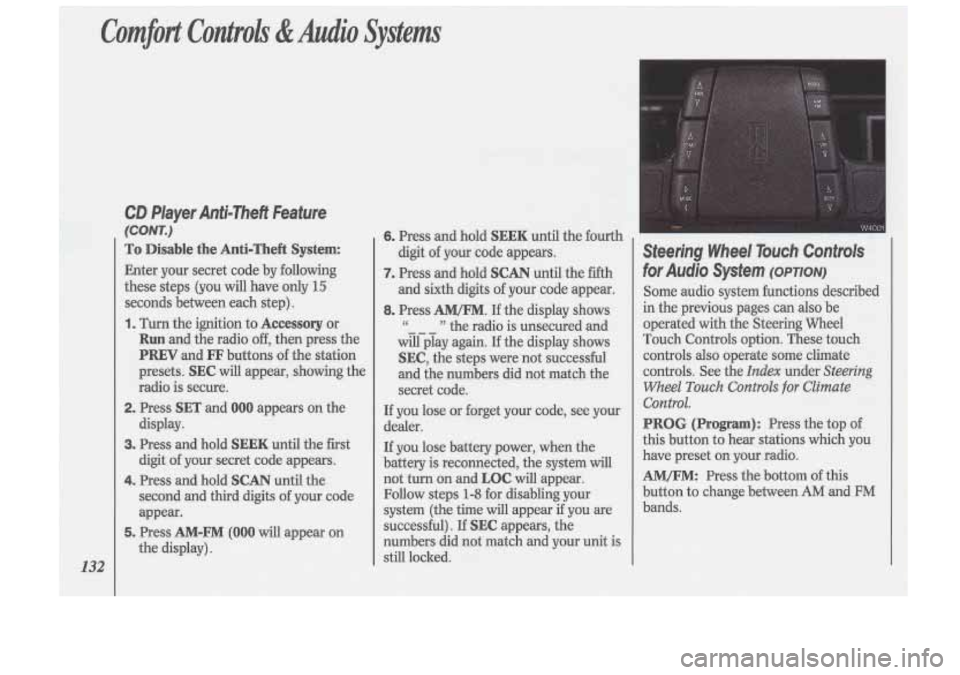
Comfort Controls &Audio Systems
132
CD Player Anti-Theft Feature
(CONT.)
To Disable the Anti-Theft System:
Enter your secret code by following
these steps (you will have only
15
seconds between each step).
1. Turn the ignition to Accessory or
Run and the radio off, then press the
PREV and FF buttons of the station
presets.
SEC will appear, showing the
radio is secure.
2. Press SET and 000 appears on the
display.
3. Press and hold SEEK until the first
digit of your secret code appears.
4. Press and hold SCAN until the
second and third digits of your code
appear.
the display).
5. Press AM-FM (000 will appear on
6. Press and hold SEEK until the fourth
digit of your code appears.
7. Press and hold SCAN until the fifth
and sixth digits of your code appear.
8. Press AM/FM. If the display shows
--- ” the radio is unsecured and
will play again. If the display shows
SEC, the steps were not successful
and the numbers did not match the
secret code.
If you lose or forget your code, see your
dealer.
If you lose battery power, when the
battery is reconnected, the system will
not turn on and
LOC will appear.
Follow steps
1-8 for disabling your
system (the time will appear if you are
successful). If
SEC appears, the
numbers did not match and your unit is
still locked.
((
Steering Wheel Touch Controls
for Audio System (OPTION)
Some audio system functions described
in the previous pages can also be
operated with the Steering Wheel
Touch Controls option. These touch controls
also operate some climate
controls. See the
Index under Steering
Wheel
Touch Controls for Climate
Control.
PROG (Program): Press the top of
this button to hear stations which you
have preset on your radio.
AM/FM: Press the bottom of this
button to change between
AM and FM
bands.
Page 156 of 340
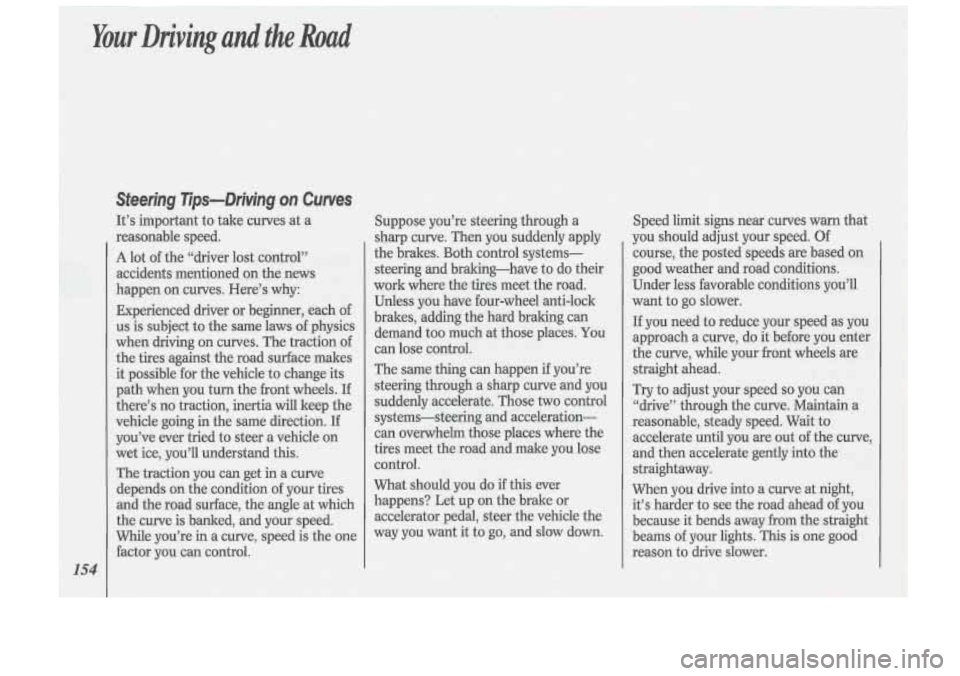
Your Driving ad the Road
Steering Tips-Driving on Curves
154
It’s important to take curves at a
reasonable speed.
A lot of the “driver lost control”
accidents mentioned on the news
happen on curves. Here’s why:
Experienced driver or beginner, each of
us is subject
to the same jaws of physics
when driving on curves. The traction of
the tires against the road surface makes
it possible
for the vehicle to change its
path when you turn the front wheels. If
there’s no traction, inertia will keep the
vehicle going in the same direction. If
you’ve ever tried to steer a vehicle on
wet ice, you’ll understand this.
The traction you can get in a curve
depends on the condition of your tires
and the road surface, the angle at which
the curve is banlted, and your speed.
While you’re in a curve, speed is the one
factor you can control. Suppose
you’re steering through a
sharp curve. Then you suddenly apply
the brakes. Both control systems-
steering and braking-have to do their
work where the tires meet the road.
Unless you have four-wheel anti-lock
brakes, adding the hard braking can
demand too much at those places.
You
can lose control.
The same thing can happen if you’re
steering through a sharp curve and you
suddenly accelerate. Those two control
systems-steering and acceleration-
can overwhelm those places where the
tires meet the road and make you lose
control.
What should you do if this ever
happens? Let up on the brake or
accelerator pedal, steer the vehicle the
way you want it to go, and slow down. Speed limit signs
near curves warn that
you should adjust your speed. Of
course, the posted speeds are based on
good weather and road conditions.
Under less favorable conditions you’ll
want
to go slower.
If you need to reduce your speed as you
approach a curve, do it before you enter
the curve, while your front wheels are
straight ahead.
Try to adjust your speed
so you can
“drive” through the curve. Maintain a
reasonable, steady speed. Wait to
accelerate until you are out
of the curve,
and then accelerate gently into the
straightaway.
When you drive into a curve at night,
it’s harder
to see the road ahead of you
because it bends away from the straight
beams of your lights. This is one good
reason to drive slower.
Page 157 of 340
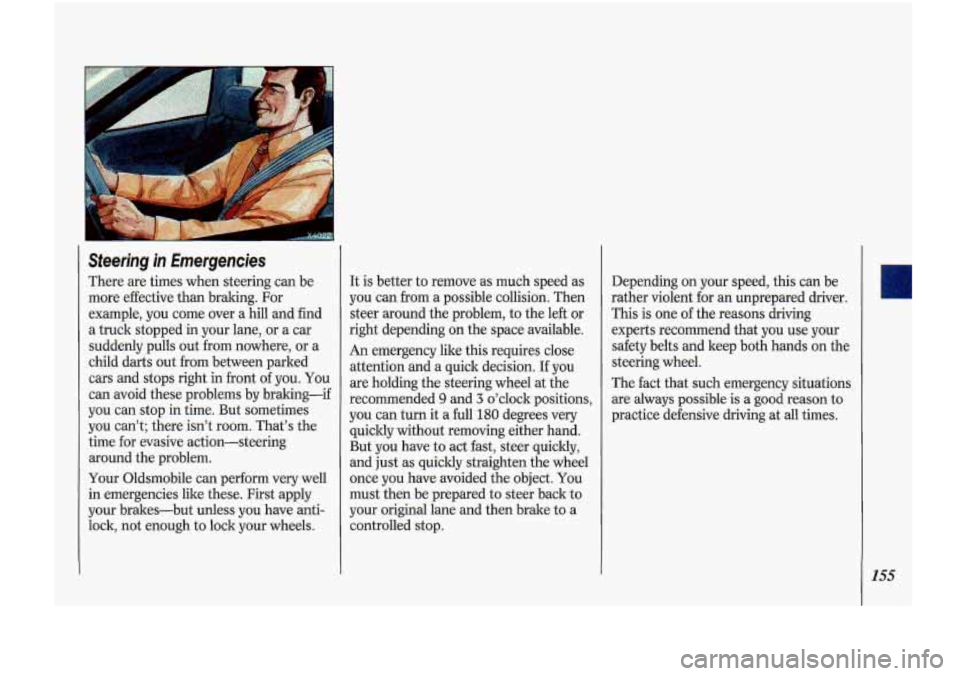
I Steering in Emergencies
There are times when steering can be
more effective than braking. For
example, you come over a hill and find
a truck stopped
in your lane, or a car
suddenly pulls out from nowhere,
or a
child darts out from between parked
cars and stops right in front of
you. You
can avoid these problems by braking-if
you can stop in time. But sometimes
you can’t; there isn’t room. That’s the
time for evasive action-steering
around the problem.
Your Oldsmobile can perform very well
in emergencies like these. First apply
your brakes-but unless you have anti-
lock, not enough to lock your wheels. It is
better to remove as much speed as
you can from a possible collision. Then
steer around the problem, to the left or
right depending on the space available.
An emergency like this requires close
attention and a quick decision. If you
are holding the steering wheel at the
recommended
9 and 3 o’clock positions,
you can turn it a full
180 degrees very
quicldy without removing either hand.
But you have to act fast, steer quickly,
and just as quickly straighten the wheel
once you have avoided the object. You
must then be prepared to steer back to
your original lane and then brake to a
controlled stop. Depending
on your speed, this can be
rather violent for an unprepared driver.
This is one of the reasons driving
experts recommend that you use your
safety belts and keep both hands on the
steering wheel.
The fact that such emergency situations
are always possible is
a good reason to
practice defensive driving at all times.
155
Page 158 of 340

Your Driving and the Road
156
Off-Road Recovery
You may find sometime that your right
wheels have dropped off the edge of a
road onto the shoulder while you’re
driving.
If the level of the shoulder is only
slightly below the pavement, recovery
should be fairly easy. Ease off the
accelerator and then,
if there is nothing
in the way, steer
so that your vehicle
straddles the edge of the pavement.
You
can turn the steering wheel up to ‘/4
turn until the right front tire contacts
the pavement edge. Then turn your
steering wheel to go straight down the
roadway.
If the shoulder appears to be about four
inches
(100 mm) or more below the
pavement, this difference can cause problems.
If there is not enough room
to pull entirely onto the shoulder and
stop, then follow the same procedures.
But
if the right front tire scrubs against
the side of the pavement, do
not steer
more sharply. With too much steering
angle, the vehicle may jump back onto
the road with
so much steering input
that it crosses over into the oncoming
traffic before you can bring it back
under control. Instead, ease
off again on
the accelerator and steering input,
straddle the pavement once more, then
try again.
Passing
The driver of a vehicle about to pass
another on a two-lane highway waits for
just the right moment, accelerates,
moves around the vehicle ahead, then
goes back into the right lane again.
A
simple maneuver?
Not necessarily! Passing another vehicle
on
a two-lane highway is a potentially
dangerous move, since the passing
vehicle occupies the same lane as
oncoming traffic for several seconds.
A
miscalculation, an error in judgment, or
a brief surrender to frustration or anger
can suddenly put the passing driver face
to face with the worst of all traffic
accidents-the head-on collision.
So here are some tips for passing:
“Drive ahead.” Look down the road,
to the sides, and to crossroads for
situations that might affect your
passing patterns. If you have
any
doubt whatsoever about malting a
successful pass, wait for a better time.
I
Page 160 of 340
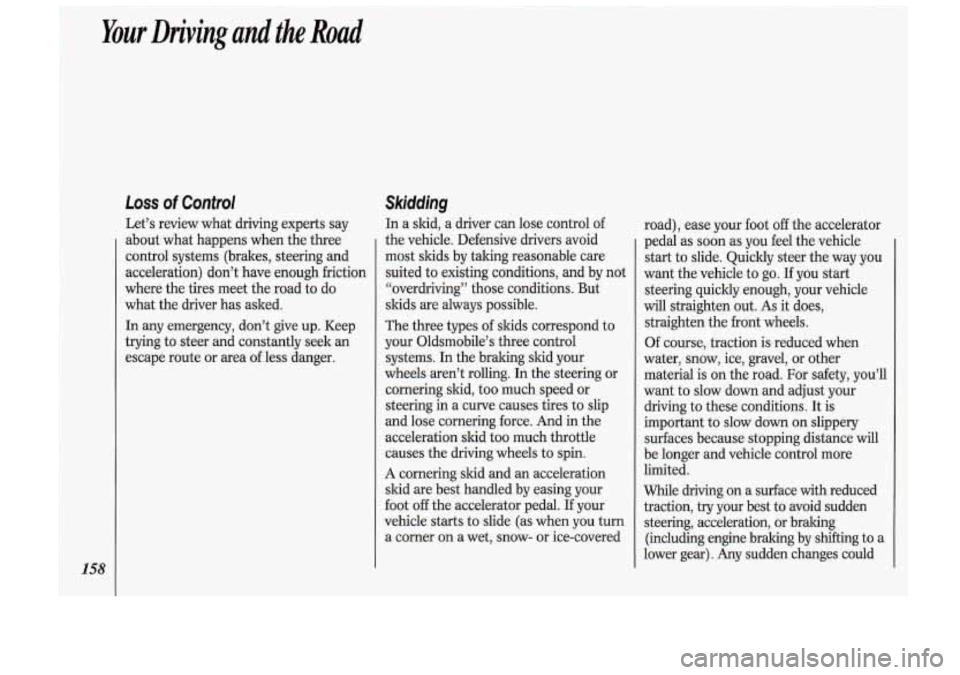
~
~~ Your Driving and the Road
158
Loss of Control
Let’s review what driving experts say
about what happens when the three
control systems (brakes, steering and
acceleration) don’t have enough friction
where the tires meet the road to do
what the driver has asked.
In any emergency, don’t give up. Keep
trying to steer and constantly seek an
escape route or area of less danger.
Skidding
In a skid, a driver can lose control of
the vehicle. Defensive drivers avoid
most skids by taking reasonable care
suited to existing conditions, and by not
“overdriving” those conditions. But
skids are always possible.
The three types of skids correspond
to
your Oldsmobile’s three control
systems. In the braking skid your
wheels aren’t rolling. In the steering or
cornering skid, too much speed or
steering in a curve causes tires to slip
and lose cornering force. And in the
acceleration skid too much throttle
causes the driving wheels to spin.
A cornering skid and an acceleration
skid are best handled by easing your
foot off the accelerator pedal.
If your
vehicle starts to slide (as when you turn
a corner on a wet, snow- or ice-covered road),
ease your foot
off the accelerator
pedal as soon as you feel the vehicle
start to slide. Quickly steer the way you
want the vehicle to go.
If you start
steering quickly enough, your vehicle
will straighten out.
As it does,
straighten the front wheels.
Of course, traction is reduced when
water, snow, ice, gravel, or other
material
is on the road. For safety, you’ll
want to slow down and adjust your
driving to these conditions. It is
important to slow down on slippery
surfaces because stopping distance will
be longer and vehicle control more
limited.
While driving on a surface with reduced
1
traction, try your best to avoid sudden
steering, acceleration, or braldng (including engine braking by shifting to a
lower gear). Any sudden changes could